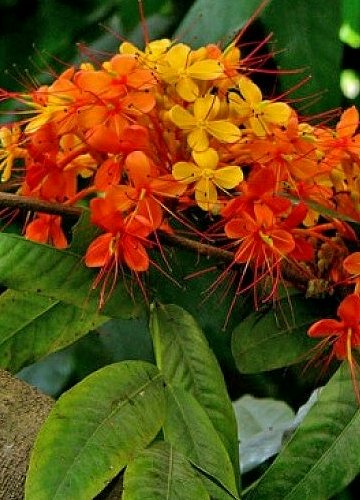
|
|
Ashoka (Saraca asoca).
|
Ashoka - Saraca asoca
Saraca asoca (the ashoka tree; lit., "sorrow-less") is a plant belonging to the Caesalpinioideae subfamily of the legume family
( Fabaceae) . It is an important tree in the cultural traditions of the Indian subcontinent and adjacent
areas. It is sometimes incorrectly known as Saraca indica.
The ashoka is a rain-forest tree. Its original distribution was in the central areas of the Deccan
plateau, as well as the middle section of the Western Ghats in the western coastal zone of the Indian
subcontinent.
Saraca asoca is an evergreen shrub or small tree with a spreading crown; it can grow up to 10 metres
tall. The bole can be 10cm in diameter. The ashoka is prized for its beautiful foliage and fragrant
flowers. It is a handsome, small, erect evergreen tree, with deep green leaves growing in dense
clusters.
Its flowering season is around February to April. The ashoka flowers come in
heavy, lush bunches. They are bright orange-yellow in color, turning red before
wilting. Biologically, some of the flower's characteristics are very dry and
abundant. This means that the flower is coated with a chemical on the outside.
As a wild tree, the ashoka is a vulnerable species. It is becoming rarer in its natural
habitat, but isolated wild ashoka trees are still to be found in the foothills of the central and eastern
Himalayas, in scattered locations of the northern plains of India as well as on the west coast of the subcontinent near
Mumbai.
There are a few varieties of the ashoka tree. One variety is larger and highly
spreading. The columnar varieties are common in cultivation. The tree is commonly grown as an
ornamental.
This small tree has become threatened in some parts of its range mainly through the loss of its habitat and overexploitation for medicinal
use. It is classified as 'Vulnerable' in the IUCN Red List of Threatened Species
(2011).
Saraca asoca is one of the most important sacred trees in
India, both among Hindus and Buddhists, the handsome flowers being commonly used as temple
decorations.
The ashoka tree is considered sacred throughout the Indian
subcontinent, especially in India, Nepal and Sri Lanka. This tree has many
folklorical, religious and literary associations in the region. Highly valued as well for its handsome appearance and the color and abundance of its
flowers, the ashoka tree is often found in royal palace compounds and gardens as well as close to temples throughout
India.[3] It is believed Shakyamuni Buddha was born under an ashoka tree in Lumbini
Garden.
The ashoka tree is closely associated with the yakshi mythological beings. One of the recurring elements in Indian
art, often found at gates of Buddhist and Hindu temples, is the sculpture of a yakshini with her foot on the trunk and her hands holding the branch of a flowering ashoka
tree. As an artistic element, often the tree and the yakshi are subject to heavy
stylization. Some authors hold that the young girl at the foot of this tree is based on an ancient tree deity related to
fertility.
Yakshis under the ashoka tree were also important in early Buddhist monuments as a decorative element and are found in many ancient Buddhist archaeological
sites. With the passing of the centuries the yakshi under the ashoka tree became a standard decorative element of Hindu Indian sculpture and was integrated into Indian temple architecture as
salabhanjika, because there is often a confusion between the ashoka tree and the sal tree
(Shorea robusta) in the ancient literature of the Indian subcontinent.
In Hinduism the ashoka is considered a sacred
tree. Not counting a multitude of local traditions connected to it, the ashoka tree is worshipped in
Chaitra, a month of the Hindu calendar. It is also associated with Kamadeva, the Hindu god of
love, who included an ashoka blossom among the five flowers in his quiver, where ashoka represent seductive
hypnosis.[7] Hence, the ashoka tree is often mentioned in classical Indian religious and amorous
poetry, having at least 16 different names in Sanskrit referring to the tree or its
flowers.
In Mahakavya, or Indian epic poetry, the ashoka tree is mentioned in the Ramayana in reference to the Ashoka Vatika
(garden of ashoka trees) where Hanuman first meets Sita.
The tree is an important herbal medicine in
Ayurveda, being used on its own and in a range of formulations, It is harvested from the wild and sold in local
markets.
The bark is a very popular herb in
Ayurveda, where it is said to be particularly useful for treating the female reproductive system[304]. It is strongly astringent and a uterine
sedative. It is said to have a stimulating effect on uterine and ovarian tissue. It is said to be useful in the treatment of several ailments including menstrual
cramps; some cases of uterine bleeding; uterine fibroids; haemorrhoids, and internal
bleeding.The bark is also useful in dyspepsia, fever, and burning sensation. The bark contains tannins and
catechol.
Source:
https://en.wikipedia.org/wiki/Saraca_asoca
http://tropical.theferns.info/viewtropical.php?id=Saraca+asoca
